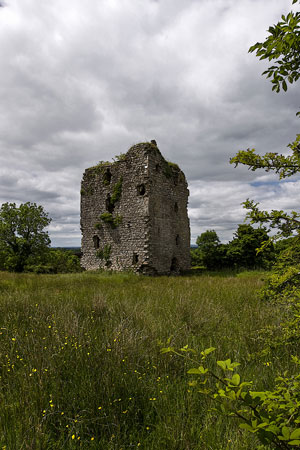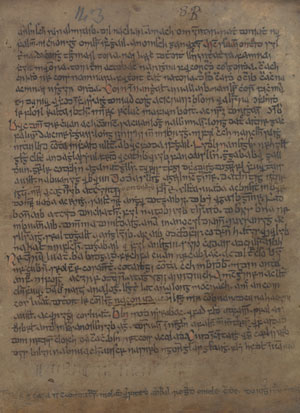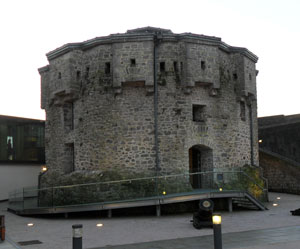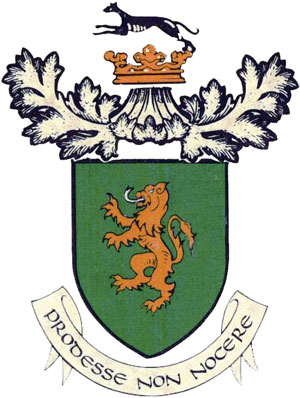SEFRAID Ó FEARGHAIL AND ANGHAILE, 1271–1318
Published in Features, Issue 1 (January/February 2023), Volume 31By Stephen Hewer
By 1270 the English had been colonising parts of Ireland for over 100 years. Many Gaelic realms or tuatha were destroyed, but others, through geographic fortune (mountainous realm or remote location) and military capability, were able to survive and adjust to the changes. A few were able to thrive. One of these realms was Anghaile on the western edge of Tír Briúin, in what is now County Longford. Anghaile was ruled by the Uí Fhearghail, the taisigh (‘rulers’ or ‘leaders’).
Sefraid mac Gilla na Naem Uí Fhearghail first appears in surviving records in 1271 (see first link below). There was no comment on his age but he must have been an adult by that point, which may mean that he was born c. 1245–53. He was not the oldest son of Gilla na Naem, as Cathal mac Gilla na Naem succeeded their father in 1274. Cathal ruled Anghaile for eight years, until 1282. Sefraid then succeeded his brother as taisech of Anghaile.
Ó FEARGHAIL GENEALOGY

Above: Caislén Mhuige Dumha (Moydow Castle) or Mornin tower-house was built for the Uí Fhearghail in the fifteenth century, near the site of the de Verdun castle destroyed in 1295.
Sefraid’s father was Gilla na Naem mac Aodh mic Amhlaibh. Gilla na Naem and Aodh mac Amhlaibh were both taisigh of Anghaile before Sefraid. Every taisech of Anghaile appears to have been an Ó Fearghail, which leads to the hazard of separating them out as fathers, uncles or distant cousins. When Sefraid’s grandfather died in 1232, one source calls him ‘Aedh Ua Fearghail’ while another calls him ‘Aodh mac Amhlaibh mic Domnaill mic Murchada mic Gilla na Naom mic Bhrain mic Shenlaich mic Eochada mic Fergail, from whom the name Ó Fergail is derived’. Most sources agree on this Ó Fearghail genealogy except that Domnall, the taisech who died c. 1172, is ‘mac Giolla na Naomh’ in one record and ‘mac Murchada’ in another.
Sefraid and his father, Gilla na Naem, are interesting for more than the extensive surviving genealogical records. Gilla na Naem was taisech for 30 years (c. 1244–74) and Sefraid was taisech for 36 years (1282–1318), which were unusually long reigns. Both first appear in the records for killing English settlers: Gilla na Naem killed John Tirel in 1248 and Sefraid killed several in 1271. Their political alliances and enemies (English and Gaelic), however, were rather different. Gilla na Naem joined the Uí Raighillig invasion of Muintir Eolais (immediately north of Anghaile) in 1253 but departed from the main force before they were routed by Aedh mac Fedlim Uí Chonchobhair. He killed Diarmait Ó Cuinn and Amhlaib, Diarmait’s son, at Faradán Maige Trega (now Clongesh) in 1255. Seven years later, the English of Meath invaded Anghaile and Gilla na Naem’s oireacht (council of nobles) abandoned him. The son of his father’s rival replaced him temporarily. Gilla na Naem immediately struck back at the English settlers and the annals attribute to these actions his return to power over Anghaile. In 1269 Gilla na Naem allied with the English to kill two other Uí Fhearghail—Domhnall and his son Aedh. When he died in 1274, Gilla na Naem was highly praised by the annals (see sidebar above/below) and was buried at Boyle Abbey.
SEFRAID’S EXCEPTIONAL CAREER

Above: Eulogy of Uilliam Ó Fearghail, taisech in 1435–45, great-grandson of Sefraid’s brother Seaán Gallda Ó Fearghail, who, like Sefraid, maintained a fleet on Lough Ree. (TCD)
Sefraid was exceptional, beginning with his name. ‘Sefraid’ was not a traditional name for the Uí Fhearghail—or, indeed, for any Gael. It first appears around 1200 for two prominent English colonisers, Sethfraigh Gogan (Geoffrey de Cogan, killed c. 1186) and Seffraigh Mares (Geoffrey de Marisco, justiciar). The first noted Gael named Sefraid was ‘Sephrid hUa Donchadha’ in 1253, and Sefraid Ó Fearghail was the third Gael recorded with the name. When he appears in English records he is always called ‘Galfridus’, Latin for Geoffrey.
After his highly noted victory in 1271, Sefraid remained largely unnoticed while his brother, Cathal, was taisech. Sefraid became taisech in 1282 and became more active in the 1290s. He assisted Aedh mac Eógain Uí Chonchobhair—who became rí Chonnacht (king of Connacht) in 1293—probably because Aedh married an Ó Fearghail woman. Aedh’s heir, Fedlimid, was their child and was born in 1293. This was not the first Ó Fearghail–Ó Conchobair marriage: Sefraid’s great-aunt (Raghnailt, sister of Aodh mac Amhlaibh) had married Aodh mac Cathail Croibhdearg (rí Chonnacht 1224–8).
Sefraid’s next actions put him on the map. In 1295 he knocked down three English castles in his territory, Magh Dumha (Moydow), Baile Nua (Newtownbond) and Magh Brecraige (Moybreckrie). The next year he, along with the Mag Ragnaill of Muintir Eolais—whom his father had fought—came to the aid of Aedh mac Eógain Uí Chonchobhair in his battle with Clann Muirchertaigh for supremacy in Connacht.
In c. 1298 Sefraid’s story takes an unexpected turn: the brother of the men that he killed in 1271, Theobald de Verdun, appeared before the justices of the Dublin Bench to defend Sefraid and his property! Moreover, this is the same Theobald whose castle at Magh Dumha Sefraid had destroyed in 1295. Remarkably, a peace deal of sorts had been hammered out shortly after. Another English settler had stolen some of Sefraid’s cows and pigs and then claimed that the theft was legal as Sefraid was an outlaw. Theobald, acting as Sefraid’s attorney, claimed that he was ‘at peace’ and thus the theft was illegal.
In 1299 Sefraid killed another English lord, John de la Mare, who was lord of the castle at Magh Brecraige, while de la Mare was out hunting. Not only did this event garner mention and even praise for the colonist, John de la Mare, in the Gaelic annals but also there is no mention of Sefraid being charged criminally in an English court for this slaying—unlike in 1271. In 1302 William de la Mare, John’s son, took a case against Sefraid for the death of his father. This was a civil case, like a wrongful death case today (Civil Liability Act 1961, 48). This civil case must have been settled out of court because a few years later William de la Mare had to ask for permission to grant lands and tenements to Sefraid for a term of years. These lands and tenements could have been Magh Brecraige, which Sefraid clearly felt were within his territory.
SEFRAID’S FLEET ON LOUGH REE
Sefraid’s actions had attracted the attention of Richard de Burgh, who had convinced William to make the settlement. Richard, as ‘lord of Connacht’, had been involved in the peace talks in 1296 between Aedh Ó Conchobair and Clann Muirchertaigh and may have met Sefraid then. William had to ask permission for this grant because Sefraid was then a ‘felon’ (outlaw) and so no English land grants to him were allowed. A regular felon would have been captured, possibly tried and executed, but Sefraid had his slúagh of armed followers and was outside the power of the English courts and bailiffs. Around the same time as the land grant, Sefraid’s naval activities on Loch Rí (Lough Ree) and the Sionainn (River Shannon) had caused the Dublin administration to order a galley to be made to patrol the waters and the English royal castles of Rinndown and Athlone to be repaired to aid the defence of the entrance into the then English ‘County Connacht’. Sefraid’s ‘felon’ status may have come from his naval attacks. A few years later (in 1310) Sefraid invaded Dún Uabhair in Cenél Fiachach (what is now the barony of Moycashel, Co. Westmeath), where he attacked the Mic Eochagáin and three Uí Fhearghail died. One source (the Annals of Loch Cé) claims that Fearghal mac Muirchertagh mór Mag Eochagáin was killed in Anghaile before the hosting south and this caused the tension between Anghaile and Cenél Fiachach. To make this hosting, Sefraid had to march through ‘English’ lands or sail across Loch Rí and then march past Athlone Castle. Either way demonstrates that local English forces could not contain him.
The crescendo of Sefraid’s career was probably this period between 1300 and 1316. He had reached the height of his power and put Anghaile on an ‘international’ stage (he was personally asked/summoned to help Edward II of England fight the Scots in 1315). That same year his relative, Fedlimid Ó Conchobair, rí Chonnacht, was routed at Granard by a family rival, Ruaidrí Ó Conchobair, and Granard was burned by Edward Bruce during his invasion. Bruce’s targets, however, appear to have been English settlements. In 1316 Sefraid was at the battle of Áth an Rí (Athenry), where Fedlimid and several notable Uí Fhearghail were killed by the English. The annals called Sefraid rí Conmaicne on that day, which was a great compliment and promotion.
DEATH
The next year Roger Mortimer (who later deposed Edward II) burned Ó Fearghail’s houses and caused him to finally submit to the colonists. A year later, in 1318, Sefraid died and the annals noted his longevity in power. He was probably between 65 and 77 years old, and no mention was made of death in battle or from disease. In 1320 Mór ingean Uí Baighil, who may have been Sefraid’s wife, died. His brother Murchad succeeded him without any mention of dispute, but the three years of Murchad’s reign saw many Uí Fhearghail die at each other’s hands, including Murchad himself in 1322.

Above: Athlone Castle—had to be repaired in the late 1290s to withstand Sefraid Ó Fearghail’s advances.
Gilla na Naem mac Sefraid then became taisech of Anghaile in 1322 and ruled for 25 years. Like his father and grandfather, he held power for a long time. He does not enter the records killing settlers, though. His only notable accomplishment, according to his death notice, was that he ‘conquered the devil’. After Gilla na Naem, the taisigh of Anghaile were all descendants of Sefraid’s brothers. They eventually split into at least two groups, Clann Seaáin (Uí Fhearghail Bán) and Clann Murchadha (Uí Fhearghail Buide), and they did maintain a presence in both English and Gaelic Ireland.
Hence we see in the life of a man such as Sefraid mac Gilla na Naem Uí Fhearghail how a Gaelic taisech could live through a turbulent time when the English colony in Ireland was at its medieval peak, yet be able to demarcate his realm of Anghaile as outside of ‘English Ireland’ and to be rewarded with favours and grants even after killing English colonists. He served as an example for the taisigh of Anghaile who followed him.
Stephen Hewer is a Leverhulme Early Career Fellow at the University of Liverpool’s Institute of Irish Studies.
Further reading
S. Hewer, Beyond exclusion in medieval Ireland: intersections of ethnicity, sex, and society under English law (Turnhout, 2021).
F. Verstraten Veach, ‘The Ó Fearghail lordship of Anghaile’, in M. Morris & F. O’Ferrall (eds), Longford history and society: interdisciplinary essays on the history of an Irish county (Dublin, 2010), 51–74.
SEFRAID’S FIRST MENTION IN THE RECORDS
CHANGING TITLES OF RULERS OF ANGHAILE

















